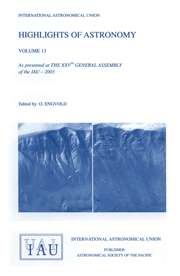No CrossRef data available.
Article contents
The Contribution of Hipparcos to the Study of the Stellar Metal-Rich Population in the Solar Neighbourhood
Published online by Cambridge University Press: 14 August 2015
Extract
The ‘1996 Edition’ of the Catalogue of [Fe/H] determinations by Cayrel de Strobel et al. (1997, A&A S 124,1) and two recent papers by Castro et al. (1997, AJ Vol.114, N.1) and by Feltzing and Gustafsson (A&A in press) have made possible to increase in the theoretical HR diagram (log Teff, Mbol the number of SMR stars.
The SMR Stars of this new enlarged sample had to have reliable absolute magnitudes, coming all from Hipparcos parallaxes, precise bolometric corrections, effective temperatures and metal abundances from high resolution detailed spectroscopic analyses.
With the help of an appropriate grid of isochrones computed by Lebreton (1997, Perryman et al. A&A, in press), ‘turn-off ages’could then be attributed to the slightly evolved stars (subgiants) of the sample. The (log Teff, Mbol) diagram constituted by the new sample of SMR stars, shows that the conclusions in a former paper by Cayrel de Strobel (1987, A&AJ 8,141) remain valid: the SMR stars areold stars in spite of their higher than solar metallicity. The result, that metal-rich stars were in the mean old stars, was interpreted in the 1987 paper as due to a more chemical uniformity of the nowadays interstellar medium of the Galaxy with respect of the older much more active interstellar medium.
- Type
- II. Joint Discussions
- Information
- Copyright
- Copyright © Kluwer 1998


